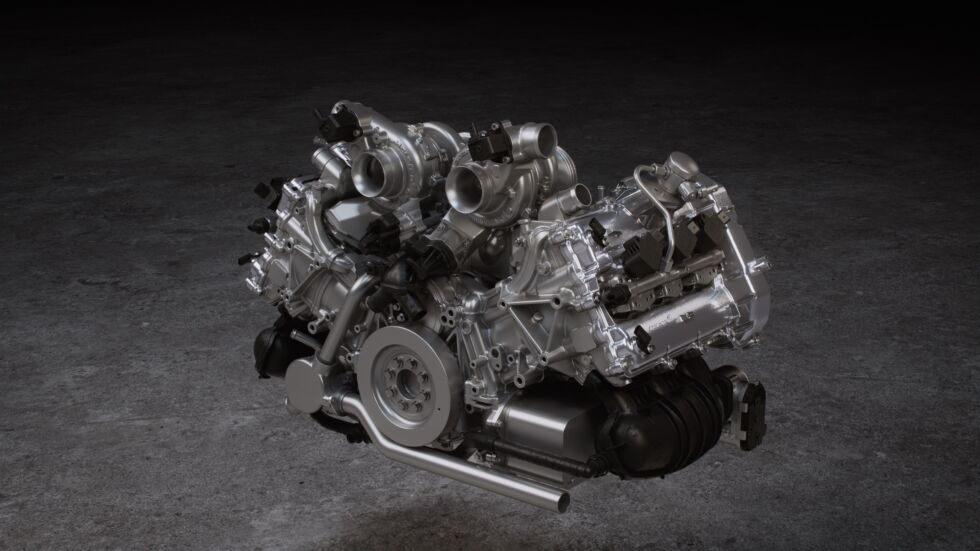205 mph —
There’s a new carbon-fiber monocoque and a 120-degree V6.
Jonathan M. Gitlin
–
McLaren’s next entry-level supercar will be the plug-in hybrid Artura, which arrives toward the end of 2021.
McLarenIt’s a clean-sheet design for the British carmaker, but it’s still recognizably a McLaren.
McLarenThe brand’s signature dihedral doors are present and correct.
McLarenOn track, the Artura’s hybrid system provides a total of 671 hp.
McLarenI’m not alone in thinking that the McLaren steering wheel is the best in the industry in terms of size and shape. Unlike cars from rivals Ferrari and Lamborghini, there’s not a single dial or button on it.
McLarenVents allow air to escape from the wheel arches.
McLarenMcLaren says the interior quality of the Artura will be a step up from the 570S.
McLarenPirelli has made special tires for the Artura that feature monitoring sensors.
McLaren
Earlier this year, McLaren unveiled its Artura supercar. When it goes on sale later in 2021, it will become the brand’s new entry-level car, replacing the “Sport Series” cars like the 570S and 600LT. And it really is all-new. All previous McLarens (except the F1) have used different variants of the same V8 engine and versions of the same carbon-fiber monocoque tubs. But the Artura is powered by a V6 plug-in hybrid powertrain, and the carbon monocoque—which has to package the high-voltage battery pack—is similarly fresh. McLaren recently sat down with Ars over Zoom to give us a deep dive into the Artura’s tech. Read on to find out what we learned.
MCLA
Until now, McLaren has outsourced production of its carbon-fiber “monocell” chassis to an Austrian company called Carbo Tech. But in 2020, McLaren opened its own composite manufacturing center in Sheffield, England, and the Artura’s chassis—dubbed the McLaren Carbon Lightweight Architecture—will be made in-house.
McLaren says more than 500 pieces of carbon fiber are laser-cut and assembled in 72 pre-forms; these make up 11 subassemblies that come together to make the finished tub. It’s not an entirely carbon car, however. Like the current Sport Series McLarens, the Artura will use aluminum body panels. But it still manages to achieve a highly respectable curb weight of 3,303 lbs (1,498 kg).

Enlarge / This is the MCLA monocoque tub and the front and rear aluminum subframes.
McLaren
A hot vee
The new engine, excitingly named M630, is a twin-turbocharged 3.0 L V6 with an output of 577 hp (430 kW) and 431 lb-ft (584 Nm). The V6 uses a 120-degree vee-angle between the cylinder banks, plus a “hot-vee” configuration, in which the turbochargers nestle in between the two banks of cylinders on top of the engine. This helps with packaging, but it also means the exhaust gases have shorter distances to travel, and the engine is therefore more responsive as a result.
It has been designed from the ground up with hybridization in mind, requiring McLaren’s engineers to be a little obsessive when it comes to reducing its length and mass to compensate for having to also pack in a lithium-ion battery pack. The V6 is about 8 inches (200 mm) shorter than McLaren’s V8. This is partly due to the car having one fewer cylinder in each bank, obviously. But the cylinders also have a smaller bore (3.5 inches/84 mm) than the V8, and McLaren direct-cast the cylinders into the block (rather than fitting wet liners), reducing the space it needed to leave between them.

Enlarge / The M630 is McLaren’s first V6 engine.
McLaren
Keeping the engine cool probably gave McLaren’s engineers some headaches. In addition to the two exhausts at the rear, a “chimney” directly above the engine provides an escape for the air pumped into the engine bay (after exiting the Artura’s high-temperature radiators) to cool the turbochargers.
Plug-in power
Manufacturers’ press photos of supercars usually feature the cars on a deserted but spectacular road or maybe smoking a tire at a private race track. But many supercars spend much of their time in town, prowling from parking space to parking space in glitzy neighborhoods for the benefit of a legion of young YouTubers.
But the writing is on the wall for idling internal combustion engines in places like London’s Knightsbridge. Mindful of that reality, McLaren made the Artura a hybrid.

Enlarge / This schematic shows the McLaren Artura powertrain layout.
McLaren
The Artura is not the company’s first hybrid road car—that honor goes to the bonkers P1. Unlike the P1, the Artura is a plug-in hybrid and capable of operating in purely electric mode, at least for short journeys, and with only 94 hp (70 kW). The electric motor is an axial flux design, and in a sign of progress, it generates 166 lb-ft (225 Nm) with a mass of 34 lbs (15.4 kg); the P1’s motor was torquier at 192 lb-ft (260 Nm) but weighed 84 lbs (38 kg). Total powertrain output is 671 hp (500 kW) and 531 lb-ft (720 Nm).
The disc-shaped motor is located inside the clutch housing between the engine and transmission, directly on the input shaft. The car’s battery pack is located ahead of the engine bay, mounted to the underside of the car’s carbon-fiber monocoque chassis. This keeps it well protected in the event of a crash, as well as putting it in the optimum spot for weight distribution and the Artura’s center of gravity. The pack has a capacity of 7.4 kWh, and McLaren says it takes 2.5 hours to charge it to 80 percent using a 240 V charger.
McLaren says that in Comfort mode, most city driving in the Artura will be under electric power, with the V6 firing up at around 37 mph (60 km/h). Maximum speed on the electric motor alone is 81 mph (130 km/h), and McLaren is targeting an electric-only range of about 19 miles (30 km) under the WLTP system.
Listing image by McLaren

